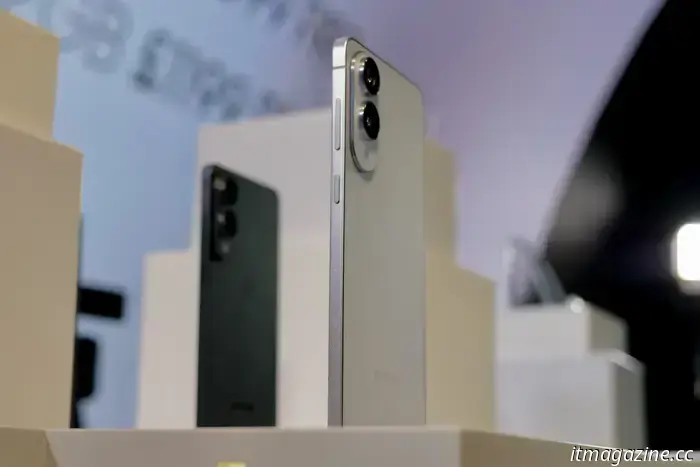
I’ve had the chance to hold the Galaxy S25 Edge, and I’m absolutely captivated.
The Samsung Galaxy S25 Edge owes its existence to its slim profile, making it essential for the device to be exceptional; otherwise, what’s the reason for its creation? Fortunately, it truly stands out and offers a design unlike any other smartphone currently on the market.
During my brief interaction with the phone, I was captivated by its sleek build. However, is its thinness compelling enough to prefer it over another model in the Galaxy S25 lineup? Here are my initial thoughts.
Emphasis on Thinness
I spent about an hour with the Galaxy S25 Edge, and as my hands-on session came to an end, I found it hard to set the phone down. This is a crucial reaction, as without this allure, one might as well opt for a standard Galaxy S25 model since the Edge doesn't provide any internal advantages.
The comfort level is what truly stands out. It doesn’t seem like Samsung merely reduced a few millimeters from the Galaxy S25+ and called it a day. The transition where the titanium frame meets the glass is delicately chamfered, eliminating the uncomfortable sharpness that comes with the Galaxy S25 Ultra.
Due to its decreased thickness and weight, it feels entirely different from the Galaxy S25+. While the specifications—5.8mm and 163 grams—might not seem revolutionary, holding the Galaxy S25 Edge offers a unique experience compared to other recent smartphones. Throughout the hour I spent with it, it never felt cumbersome, there were no awkward angles, and I always felt in control of the phone. It’s light without being flimsy, and it didn’t add any noticeable weight in my pocket.
Durability Concerns
I understand your concerns: with such a thin and light design, can it still endure daily use, or will it bend with a gentle breeze? The frame is made of titanium and is part of the subframe, giving it more structural integrity beyond aesthetics. The front features Corning Gorilla Glass Ceramic 2 for the first time in a smartphone, while the back is protected by Gorilla Glass Victus 2.
It certainly doesn’t feel flimsy, and I didn’t notice any immediate flex during attempts to twist it. While I believe one could break the Galaxy S25 Edge with enough effort, that risk applies to any smartphone. I would also be surprised if Samsung hadn’t vigorously tested the S25 Edge, as they would want to avoid any negative press similar to "Bendgate 2."
For those worried about durability, a case could be an option; however, that would diminish the pleasure of its slim chassis. Alternatively, one could treat the S25 Edge as one would an expensive piece of jewelry or contrasting sunglasses. The Galaxy S25 Edge offers a blend of the functional design seen in the S25 Ultra and the broad appeal of the standard S25. Its design is prominent and may attract the fashion-forward, yet it might not capture the interest of those looking for a more utilitarian device. It’s a bit disappointing that Samsung hasn’t explored bolder colors for this model. Among the three available shades—Jet Black, Titanium Silver, and Icy Blue—only the Icy Blue adds some flair.
Is it Just a Thinner S25?
The specifications of the Galaxy S25 Edge align with the S25 series. It features a 6.7-inch display with Quad HD resolution and a peak brightness of 2,600 nits, powered by the Qualcomm Snapdragon 8 Elite for Galaxy processor, supported by 12GB of RAM and either 256GB or 512GB of internal storage, running One UI 7 on Android 15. It includes all the AI capabilities from other S25 devices, and Samsung promises seven years of major OS and security updates.
Regarding the camera, the 200-megapixel main lens is identical to that of the Galaxy S25 Ultra, though the module has been reduced in size by 18% to fit the new design. The S25 Ultra’s 200MP camera hasn’t received overwhelming acclaim, so this might not be the standout feature Samsung is hoping for. Accompanying it is a 12MP wide-angle lens, but there’s no telephoto option available. If users want telephoto capabilities, they must opt for the Galaxy S25, S25+, or S25 Ultra. This is a significant drawback, particularly since even mid-range devices now commonly include telephoto lenses, leaving the S25 Edge reliant on its thin profile to attract buyers.
The battery, a 3,900mAh cell, is optimized by Samsung to provide up to 24 hours of video playback from a single charge. However, with a smaller capacity compared to the regular Galaxy S25, expect a full day of use only if extensive gaming is avoided. Unfortunately, the S25 Edge supports only 25W wired charging rather than the 45W found in some other models. More time spent with the device will shed more light on its camera






Other articles
 Samsung's top OLED TV for 2024 is available at a discount this week.
The Samsung 77-inch S95D 4K OLED is an excellent television that is currently available at a significant discount this week. It is now priced at $3,000, reduced from its original MSRP of $4,600, so it’s advisable to buy it soon.
Samsung's top OLED TV for 2024 is available at a discount this week.
The Samsung 77-inch S95D 4K OLED is an excellent television that is currently available at a significant discount this week. It is now priced at $3,000, reduced from its original MSRP of $4,600, so it’s advisable to buy it soon.
 Missed the unveiling of the Galaxy S25 Edge? Catch the complete reveal here.
If you were unable to catch the online presentation revealing Samsung's slimmest Galaxy S series smartphone to date, you can view it here.
Missed the unveiling of the Galaxy S25 Edge? Catch the complete reveal here.
If you were unable to catch the online presentation revealing Samsung's slimmest Galaxy S series smartphone to date, you can view it here.
 Why was Suits LA discontinued? An NBC executive shares insights on the unexpected choice.
A few days have passed since NBC unexpectedly decided to cancel Suits LA. Discover the reasons behind the show's cancellation after just one season.
Why was Suits LA discontinued? An NBC executive shares insights on the unexpected choice.
A few days have passed since NBC unexpectedly decided to cancel Suits LA. Discover the reasons behind the show's cancellation after just one season.
 The Galaxy S25 Edge marks the beginning of the era for slim flagship smartphones.
The Samsung Galaxy S25 Edge has been completely unveiled, and here's all the information you need to be aware of.
The Galaxy S25 Edge marks the beginning of the era for slim flagship smartphones.
The Samsung Galaxy S25 Edge has been completely unveiled, and here's all the information you need to be aware of.
 5 sci-fi films on Netflix that you should check out in May 2025.
Here are five sci-fi films you should check out on Netflix in May, featuring a sequel to Venom, a new Sonic installment, and an adventure in Ghostbusters.
5 sci-fi films on Netflix that you should check out in May 2025.
Here are five sci-fi films you should check out on Netflix in May, featuring a sequel to Venom, a new Sonic installment, and an adventure in Ghostbusters.
 The Europa Clipper spacecraft captures impressive thermal images of Mars.
A NASA spacecraft is en route to Europa, one of Jupiter's moons, but it captured some photos of Mars during its journey.
The Europa Clipper spacecraft captures impressive thermal images of Mars.
A NASA spacecraft is en route to Europa, one of Jupiter's moons, but it captured some photos of Mars during its journey.
I’ve had the chance to hold the Galaxy S25 Edge, and I’m absolutely captivated.
I have handled and utilized the Samsung Galaxy S25 Edge, and its remarkable slimness has truly impressed me.
